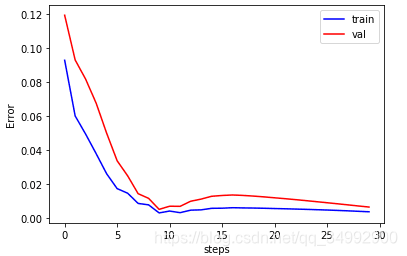问题描述
基于简单数据的图卷积神经网络展示,假设有5个空间相关的点(nodes),每个点有一个特征(feature),通过图卷积利用5个点的数据对某一点数据进行订正。
参考多篇博客和github代码基于python编译了图卷积神经网络,主要使用pytorch实现图卷积,具体是否正确还请各位大佬多多指教。
数据的预处理
- 数据预处理
研究中基于点的距离建立了***adjacency matrix***,代码如下
lon_lat = np.array([[32.0464,101.831],[32.0725,101.841],[32.0756,101.712],[32.1031,101.631],[31.94,101.148]])
#利用geodesic计算地球表面距离
a = np.ones((5,5))
for i in range(0,5):
for j in range(0,5):
a[i,j] = geodesic(lon_lat[i,:], lon_lat[j,:]).km
#以15km为界限,建立adjacency matrix
a[np.where(a<=15)] = 1
a[np.where(a>15)] = 0
a = a-np.eye(5,5)
- 计算Degree Matrix
计算Degree Matrix代码使用https://github.com/johncava/GCN-pytorch.git 所提供代码
def preprocess(A):
# Get size of the adjacency matrix
size = len(A)
# Get the degrees for each node
degrees = []
for node_adjaceny in A:
num = 0
for node in node_adjaceny:
if node == 1.0:
num = num + 1
# Add an extra for the "self loop"
num = num + 1
degrees.append(num)
# Create diagonal matrix D from the degrees of the nodes
D = np.diag(degrees)
# Cholesky decomposition of D
D = np.linalg.cholesky(D)
# Inverse of the Cholesky decomposition of D
D = np.linalg.inv(D)
# Create an identity matrix of size x size
I = np.eye(size)
# Turn adjacency matrix into a numpy matrix
A = np.matrix(A)
# Create A hat
A_hat = A + I
# Return A_hat
return A_hat, D
- 神经网络的搭建
基于pytorch搭建图卷积神经网络,卷积过程代码参考https://github.com/johncava/GCN-pytorch.git
#Pytorch 搭建神经网络标准开头
class GCN_net(nn.Module):
def __init__(self,A,D):
super(GCN_net, self).__init__()
self.tn_fc0 = nn.Linear(5,5)
self.tp = nn.Linear(5,1)
#基于adj matrix 和 Degree matrix 计算 Laplacian matrix
def DA_cal(self,x,A,D):
[row,col] = x.shape
A = [A]*row
A = np.array(A)
D = [D]*row
D = np.array(D)
A = torch.from_numpy(A)
A = A.float()
A = Variable(A, requires_grad=False)
D = torch.from_numpy(D)
D = D.float()
D = Variable(D, requires_grad=False)
DA = torch.matmul(D, A)
DA = torch.matmul(DA, D)
return DA
#图卷积函数,卷积过程在三维矩阵上进行,
#最后结果reshape为二维矩阵
def DA_cov(self, x,A,D):
[row,col] = x.shape
DA = self.DA_cal(x,A,D)
x = x.reshape(row,5,1)
x = torch.matmul(DA,x)
x = x.reshape(row,5)
return x
#基于图卷积的前向转播
def forward(self, x,A,D):
x = self.DA_cov(x,A,D)
x = F.tanh(self.tn_fc0(x))
x = self.DA_cov(x,A,D)
x = self.tp(x)
return x
- 神经网络训练参数设置
pytorch三板斧之一,设置学习率,batch size ,epoch,训练算法等,在图卷积中需要确定的参数仅为每一层之间的weight matrix
EPOCH = 100
BATCH_SIZE = 64
LR = 0.005
net = GCN_net(A,D)
optimizer = torch.optim.Adam(net.parameters(), lr = LR, weight_decay=0)
loss_function = nn.MSELoss()
- 神经网络训练
pytorch第三板斧,打完收工
records = []
loss_list = []
v_loss_list = []
for epoch in range(EPOCH):
losses = []
for step,(x,y) in enumerate(train_loader):
b_x = Variable(x.view(-1, 5))
b_y = Variable(y.view(-1, 1))
net.train()
outputs = net(b_x,A,D)
optimizer.zero_grad()
loss = loss_function(outputs, b_y)
loss.backward() # 误差反向传播, 计算参数更新值
optimizer.step() # 将参数更新值施加到 net 的 parameters 上
if step % 50 == 0:
val_loss = []
net.eval()
for step,(vx,vy) in enumerate(vaild_loader):
v_x = Variable(vx.view(-1, 5))
v_y = Variable(vy.view(-1, 1))
v_out = net(v_x,A,D)
v_loss = loss_function(v_out, v_y)
val_loss.append(v_loss)
print('Epoch: ', epoch, '| train loss: %.4f' % loss.data.numpy(), '| vaild loss: %.4f' % v_loss.data.numpy())
loss_list.append(loss.data.numpy())
v_loss_list.append(v_loss.data.numpy())
plt.figure(26)
plt.plot(loss_list,color = 'blue')
plt.plot(v_loss_list, color = 'red')
plt.xlabel('steps')
plt.ylabel('Error')

5. 问题与请教
安装参考文献和参考的代码简单编写的图卷积神经网络,其实编写成功后很心虚,代码的准确性尚待探究,还请各位大佬多多指教,有什么问题还请不吝赐教。
对于图神经网络的理论,我也是一知半解,如果有什么好的学习资料,还请大家多多分享啊!
[1]: Kipf, Thomas N., and Max Welling. “Semi-supervised classification with graph convolutional networks.” arXiv preprint arXiv:1609.02907 (2016).
[2]: https://github.com/johncava/GCN-pytorch.git





















 5282
5282

 被折叠的 条评论
为什么被折叠?
被折叠的 条评论
为什么被折叠?








